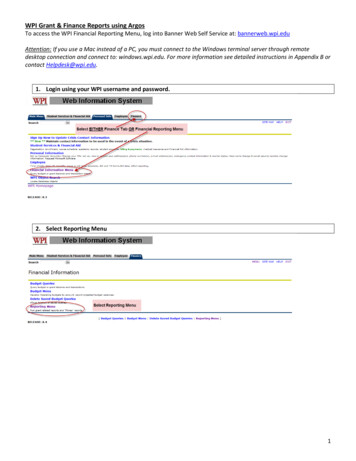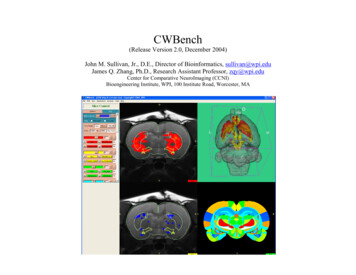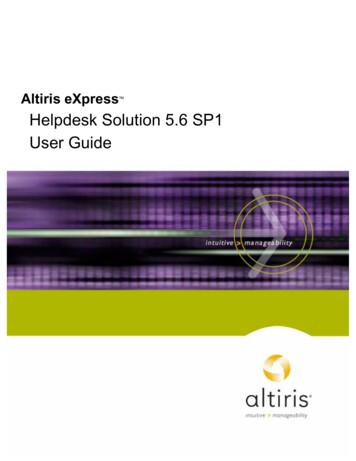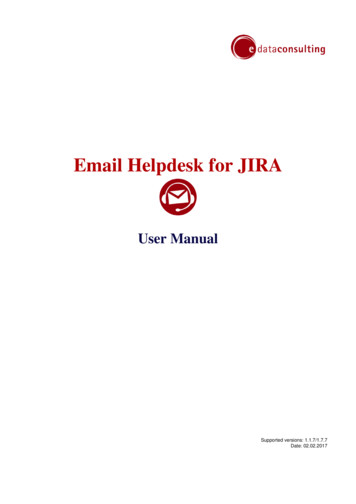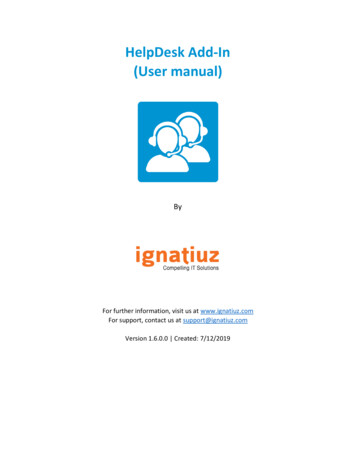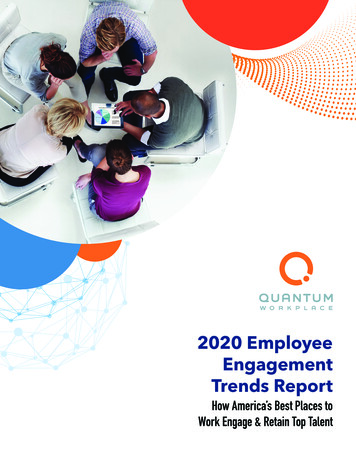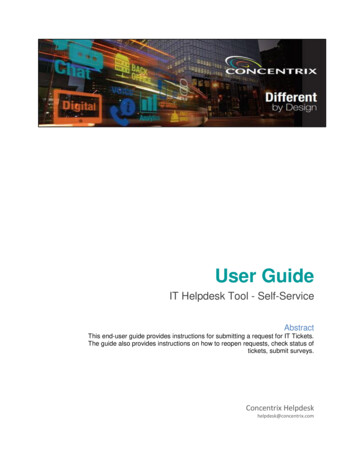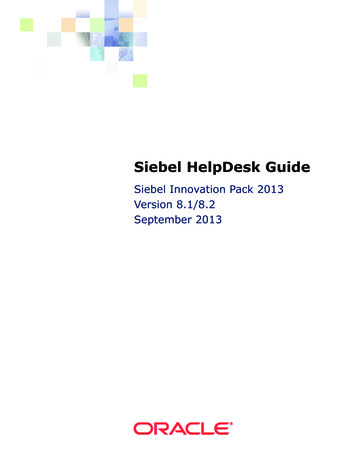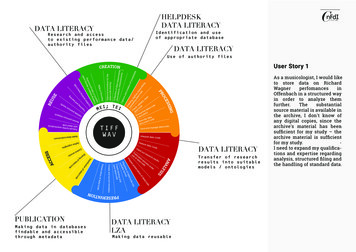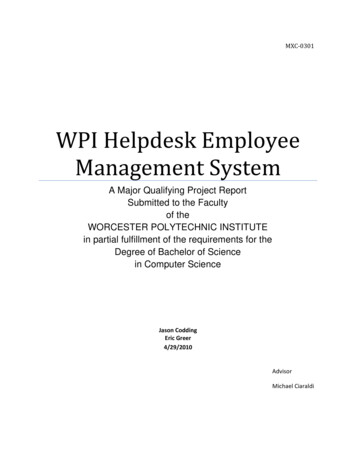
Transcription
MXC-0301WPI Helpdesk EmployeeManagement SystemA Major Qualifying Project ReportSubmitted to the Facultyof theWORCESTER POLYTECHNIC INSTITUTEin partial fulfillment of the requirements for theDegree of Bachelor of Sciencein Computer ScienceJason CoddingEric Greer4/29/2010AdvisorMichael Ciaraldi
AbstractThe goal of this project was to design and develop an employee management system for the WPIHelpdesk. This system was developed to fill existing gaps in the electronic management of employees.The scope of the project included researching and evaluating various Web technologies and analysis anddesign of employee profiles, electronic timesheets, employee performance reviews, and an integratedhiring process. Development work included construction of the core system framework, creation andmanagement of accounts, employee profiles, and electronic timesheets, and a foundation for futuremodules.i
Table of ContentsAbstract . iTable of Contents . iiTable of Figures . ivTable of Tables . iv1Introduction . 12Background . 22.12.1.1Project Focus Shift. 22.1.2Functional Requirements . 22.1.3Manager Functionality: . 42.1.4Employee Functionality:. 52.1.5Nonfunctional Requirements: . 52.23System Functionality . 103.1.1Scenarios . 103.1.2Use Cases . 103.1.3Data Model Diagrams . 123.1.4Prioritization of Features . 143.2User Interface . 16Implementation . 184.1Technology . 184.1.1Google App Engine . 184.1.2EXT GWT. 194.25Technology Exploration . 6System Design . 103.14Business Need . 2System Components . 204.2.1Login/User Accounts . 204.2.2User Profile. 214.2.3Timesheets . 23Future Development . 265.1Deployment Instructions . 265.2Know Issues . 26ii
5.3Additional Functionality . 27Appendix A: Scenarios . 28Appendix B: Use Cases . 31Appendix C: Screenshots. 40Appendix D: Timeline . 42Appendix E: Detailed Data Requirements. 43iii
Table of FiguresFigure 1: User Profile Data Model Diagram . 12Figure 2: Timesheet Data Model Diagram . 12Figure 3: Review Data Model Diagram . 13Figure 4: Hiring Data Model Diagram . 13Figure 5: System Architecture . 20Figure 6: Login Form . 20Figure 7: Account Listing . 21Figure 8: Employee Profile From. 22Figure 9: Position Management . 23Figure 10: Employee Profile Listing . 23Figure 11: Manager Timesheet Listing . 24Figure 12: Timesheet View. 25Figure 13: Timesheet Details . 25Figure 14: Example PDF Timesheet. 40Figure 15: Position Listing . 40Figure 16: Edit Position Form . 41Figure 17: Change Password Form. 41Table of TablesTable 1: Technology Comparison . 8Table 2: Project Timeline . 42iv
1 IntroductionThe goal of this project was to work with the WPI Helpdesk to automate processes and improveefficiency for the organization. This was accomplished by creating a Web based employee managementsystem. While discussions began around the desire to improve the scheduling algorithm the projectfocus evolved into the creation of a complete system for managing many data maintenance andworkflow operations. Those employee management tasks that we selected to integrate in the systemincluded: employee profiles, electronic timesheets, employee performance reviews, and the hiringprocess. Early phases of the project began with the research and evaluation of a variety of Webtechnologies and comparing their capabilities with our system, security, functional, and user interfacerequirements. Application development work included working with Google App Engine, Google WebToolkit, and the EXT-GWT Extension Library. Our analysis, design, and implementation procedures andoutcomes are detailed throughout this document.1
2 Background2.1 Business NeedSince our freshman year (2006-2007) both project partners have been WPI Helpdesk employees. Thisallowed us to witness firsthand the difficulties of managing a student employee workforce. One of theissues that arose every year was creating a schedule for all employees that met their preference andcourse schedule requirements but also provided an adequate and fair delegation of hours. Previousimplementations of scheduling systems included CGI based HTML forms, Excel spreadsheets, and sharedOutlook calendars. Thus, when project discussions first began the intent was to create a new Websitebased system that would provide increased functionality and better schedule management capabilitiesfor the Helpdesk manager. It was also about this same time that the Helpdesk began testing yet anothernew scheduling system called WhenToWork1.2.1.1 Project Focus ShiftAs project discussions continued with WPI Helpdesk student staff and management it became evidentthat the WhenToWork system was providing a useful algorithm and interface for the scheduling ofemployee hours. However, these discussions also exposed a greater need: the ability to easily completemany of the repetitive employee management tasks. There was no simple and universal way for keepingtrack of all user contact details, their employee ranking, user responses to solutions, and generalcomments. These discussions and further analyses of the business need led to the design of what wenow refer to in full as the ‘WPI Helpdesk Employee Management System’.2.1.2 Functional RequirementsThe following sets of functional requirements were created in cooperation with Helpdesk managementand student staff. These requirements describe the initial business processes that were to be handledby the Employee Management System. The requirements were categorized into the system1WhenToWork is on online scheduling system. Details on this product can be found on their Website athttp://whentowork.com/2
components that reflect the primary tasks associated with employee management. Additionally, moredetailed data requirements can be found in Appendix E: Detailed Data Requirements.2.1.2.1 User Profile:The user profile contains the employee’s biographical, employment, and positions details. The userprofile is described in full detail in section 4.2.2 User Profile. Allow multiple 5 star tickets2Allow multiple social networksCreate an user profile from an application2.1.2.2 Timesheets:The Timesheets component processes the bi-weekly payroll for all Helpdesk employees. It is describedin full detail in 4.2.3 Timesheets. Pull data from the WhenToWork schedule to generate timesheetPrinting super scripts, and notes with any special casesExport to a universally printable objectGenerate default time sheet for each employeeAuto assign new timesheets to employeesAbility to create blank timesheetCalculate gross pay2.1.2.3 Performance Reviews:The performance reviews are an annual questionnaire process undertaken by the WPI HelpdeskManager to evaluate and provide feedback for each employee. This component establishes anelectronic means of creating the questionnaires, collecting the responses, and storing them for futurereference. 2Create reviews based on of existing templatesBulk assign review to employeesTickets that receive five stars (the highest rating) on the customer feedback survey3
2.1.2.4 Hiring Process:The hiring process is the procedure through which a perspective employee applies to the Helpdesk via aWeb application. The manager is then able to retrieve and review applications before accepting ordenying their employment. The manager may also add comments and interview notes for eachapplicant. 2.1.3Display visible templatesNotify manger of new applicationsCAPTCHA3 protectionManager Functionality:2.1.3.1 User Profile: Has exclusive edit privileges on an Employee’s:o Nameo Gendero Date of Birtho Federal Work Study vs. Noto Hire Dateo Rankingo Ranking Commentso Goalso 5-Star Tickets Add Positions for Helpdesk workers Modify Positions for Helpdesk workers Ability to manually create user profile2.1.3.2 Time Sheets:Approval time sheetsAbility to print default/blank timesheets for individualsArchive timesheets for a pay periodPrint all time sheetsPrint select time sheetsMark timesheets as printed2.1.3.3 Performance Reviews: Create Templates Modify Templates3CAPTCHA is a robot prevention measure used on Web forms that requires users to enter a word displayed in animage before submitting. More details can be found at http://captcha.net4
Save TemplatesFinalize TemplateAbility to bulk issue user reviewsSet visibility on Manager reviewsSave In Progress ReviewsComplete Outstanding ReviewsView User’s reviewsView Users who have not Completed their User Review2.1.3.4 Hiring Process:Receive Notification of new applicationsCreate Sticky NotesAutomatic Job Offer/Rejection notifications as Helpdesk@wpi.eduDelete an Application2.1.4Employee Functionality:2.1.4.1 User Profile: Does not have edit privileges on own:o Nameo Gendero Federal Work Study vs. Noto Hire Dateo Rankingo Ranking Commentso Goals Can set the initial values of:o Gendero Date of Birth2.1.4.2 Time Sheets: Ability to add/edit/remove special cases Ability to submit timesheet2.1.4.3 Performance Reviews:View Review HistorySave In Progress ReviewsComplete Outstanding Reviews2.1.5 Nonfunctional Requirements:Supports Roughly 50 UsersProtects personal data99% up time5
Cross browser compatibilityLoggingo Timesheetso HiringBackupsSystem must be well documentedo Codeo User FunctionsHelpdesk Maintainable server2.2 Technology ExplorationUpon completion of the requirements for the application we began to review the many Webtechnologies that were available to us. We soon discovered that the days of simple HTML and JavaScriptwere long over and a plethora of competing technologies presented themselves as viable options. Thisprovided an opportunity to research the benefits and drawbacks of each technology and determinewhich might be the most viable and appropriate solution for our project. Our first step was to catalogthe positives and negatives of each technology to determine what role they could play in ourapplication. A complete listing of these details can be found in Table 1 following this section. It was alsoimportant for us to understand how the various back-end technologies worked with the client sideinterface and database storage options.One of the first technologies we explored was Ruby on Rails. However, it was soon discovered thatRuby’s age of being the prime Internet technology had already passed. Furthermore, it was no longerproperly configured on the WPI CCC servers, which made configuring a standard project for testing andexploration difficult. Our research of these technologies, in conjunction with an understanding that theframework generated within a Ruby on Rails application would be too cumbersome for our project,encouraged us to continue our exploration of other technologies.6
The next technology to receive a great deal of experimentation and even system modeling and democreation from us was Adobe Flex. Having explored Adobe Flex in conjunction with Java Springframework while interning at Fidelity over the summer, Jason had some experience with the technologyand believed that it might be a viable option. Flex provided native grid components and was designedto handle large amounts of data passed in XML. However, it soon became apparent that without thesupport of a technology team and support staff the ease of use was not equivalent to what had beenexperienced in the enterprise environment over the summer. Additionally, as Adobe Flex products arecompiled into Flash there was some concern as to the cross platform and mobile capability. It was alsoduring this time that we began discussions with WPI CCC server administrators to ensure that ourapplication would have a long term home where it could be hosted and utilized by the WPI Helpdesk.Due to security and maintenance concerns they were unwilling to provide and support a full Java Springenvironment. They would however be willing to consider a lighter Java environment if there was ademonstrated business need. These concerns, in addition to our recent introduction to GoogleApplication Engine (GAE) and Google Web Toolkit (GWT), prompted us to make a final developmenttechnology transition.Having recently completed a much smaller Web application in the course Webware (CS-4241) using GAEand GWT, we made a final decision that it was the most appropriate Web technology given the scopeand requirements of our application. CCC Administrators were also willing to consider the long term useof GAE on WPI machines. Google Application Engine is Java based and utilizes a local data store thatallows the passing and storing of Java objects. It was a relatively new technology but had an active userbase which we believed would be helpful in development. Additional details on GAE, GWT, and theadditional GUI extension that we selected can be found in the technology implementation section.7
Table 1: Technology ComparisonNameApplicationJava ServerPages (JSP)WebASP.NetWebAdobe FlexWebSpring(MVC)ServerJavaServerFaces (JSF)JavaServletMySQLCons- Virtual Hostingcan causeproblems- Steep learningcurve- Unfamiliarlanguages- ProprietaryLanguageOther NotesWPI SupportedJavaPages arecompiled intoJava Servlets.No- Possible x64issuesActionScript- Fairly newtechnology- Extensivetechnology tolearn in limitedtime verPages(ASP)Web- PlatformDependant- Memory Usage- Dead - Complex syntaxVBScriptNoPerl ServerPages (PSP)PHPWebPearlNo- Error Handling,- Guaranteed NOWPI supportPHPNoOracleAccess2007GroovyStrutsJava s- Platformindependent- Custom taglibraries- ODBC & JDBC- Mobile DeviceSupport- ServerRendered pages- Login control(2.0)- Cross browserstandardization(through flash)- Familiarity- Integrates withJSP, or Flex- Available- Familiarity- ODBC- Activecommunity- past experience- vaJava8NoRecommendedSpring backendNew (2007)NoMaybeNoNo
Technology Research ReferencesNameURL(s)Java Server l/WebAppDev/Pages (JSP) //Java.sun.com/products/jsp/jsp eneral .aspxhttp://www.w3schools.com/aspnet/aspnet newfeatures.aspAdobe tp://www.springsource.org/JavaServerFaces /ActiveServer(ASP)PearlServerPages tmlhttp://www.hostreview.com/guides/General Java neral /www.hostreview.com/guides/General Information/articles/081212choosingaWeb.html9
3 System Design3.1 System Functionality3.1.1 ScenariosIn order to adequately prepare for the development of the application we began by creating a variety oflikely scenarios that our system would encounter. We aimed to be as inclusive as possible. Thescenarios’ titles are listed below and described in full detail in Appendix A: Scenarios.- User Applies to Helpdesk- Manager Reviews New Application- Manager Posts- Manager Hiring Decision- User Time Sheet- Manager Time Sheet- Manager Performance Review- User Performance Review3.1.2 Use CasesContinuing from the scenarios we created use cases. These were more defined situations that allowedus to fully grasp the flow of the system from a user perspective and allow us to model how we wantedto then perform those actions on the system level, both client side and via the associated serverfunction calls. The use cases we created are listed here and described in detail in Appendix B: UseCases.GENERAL:- LoginUSER PROFILE:- Employee Adds/Updates content in user profile- Manager Adds/Updates content in user profile10
TIMESHEET:- View Timesheet- Add Special Case- Edit Special Case- Remove Special Case- Submit Timesheet- Timesheet Approval- Print All Timesheets- Select Timesheets to Print- Deselect Timesheets from list of selected timesheets- Print Selected Timesheets- Printing Status Report- Mark Printed Timesheets as Printed- Reprint TimesheetsPERFORMANCE REVIEWS:-Create Template from ScratchCreate Template from Existing TemplateAdd New Question to TemplateAdd Existing Question to TemplateRemove Question from TemplateFinalize TemplateSelect Managers to fill out reviewsSelect Employees to Deploy ReviewsDeploy ReviewChange Visibility on Individual ReviewChange Visibility on All ReviewsComplete ReviewView All Completed ReviewsHIRING:- User submits application- Manager Views Application- Manager Adds notes to Application- Manager Adds Ratings to Application- Manager Accepts Application11
3.1.3Data Model DiagramsThe following diagrams display our initial design for the application and data store objects. Theyrepresent the breakdown of the application data into appropriate Java objects that we are able to passbetween client and server within the application. It also displays the specific data attributes storedwithin each of these objects.Figure 1: User Profile Data Model DiagramFigure 2: Timesheet Data Model Diagram12
Figure 3: Review Data Model DiagramFigure 4: Hiring Data Model Diagram13
3.1.4 Prioritization of FeaturesBefore we began development we also felt it was very important to prioritize the features as much aspossible. This listing displays the priority levels that were assigned to each of the functionalityrequirements with discussion and input from WPI Helpdesk management. This prioritization allowed usto focus first on those features thought to be most valuable to our end customer, the WPI Helpdesk.The system components were prioritized in the order they are listed (User Profile, Timesheets,Performance Reviews, and Hiring Process). User Profile was determined to be the highest priority as itcontains all employee data and is the primary referenced object for each user. The remainingcomponents were placed in order of importance relayed to us by the WPI Helpdesk Management.Within each component the specific features were prioritized in order of system development necessityand are arranged as such with denotations starting with the letter A.3.1.4.1 System Functionality:User Profile:A Create an user profile from an applicationB Allow multiple 5 star ticketsC Allow multiple social networksTimesheets:A Export to a universally printable objectB Ability to create blank timesheetC Pull data from the WhenToWork schedule to generate timesheetD Generate default time sheet for each employeeE Auto assign new timesheets to employeesF Printing super scripts, and notes with any special casesG Calculate gross payPerformance Reviews:A Create reviews based off of existing templatesB Bulk assign review to employeesHiring Process:A Display visible templatesB Notify manger of new applications14
CCAPTCHA4 protection3.1.4.2 Manager Functionality:User Profile:A Ability to manually create user profileB Add Positions for Helpdesk workersC Modify Positions for Helpdesk workersD Has exclusive edit privileges on an Employee’s: Name Gender Date of Birth Federal Work Study vs. Not Hire Date Ranking Ranking Comments Goals 5-Star TicketsTime Sheets:A Ability to print default/blank timesheets for individualsB Print select time sheetsC Print all time sheetsD Approval time sheetsE Mark timesheets as printedF Archive timesheets for a pay periodPerformance Reviews:A Create TemplatesB Finalize TemplateC Ability to bulk issue user reviewsD View User’s reviewsE Complete Outstanding ReviewsF Save In Progress ReviewsG Save TemplatesH Modify TemplatesI Set visibility on Manager reviewsJ View Users who have not Completed their User ReviewHiring Process:A Create Sticky Notes4CAPTCHA is a robot prevention measure used on Web forms that requires users to enter a word displayed in animage before submitting. More details can be found at http://captcha.net15
BCDReceive Notification of new applicationsDelete an ApplicationAutomatic Job Offer/Rejection notifications as Helpdesk@wpi.edu3.1.4.3 Employee Functionality:User Profile:A Can set the initial values of: Gender Date of BirthB Does not have edit privileges on own: Name Gender Federal Work Study vs. Not Hire Date Ranking Ranking Comments GoalsTime Sheets:A Ability to submit timesheetB Ability to add/edit/remove special casesPerformance Reviews:A Complete Outstanding ReviewsB Save In Progress ReviewsC View Review History3.2 User InterfaceOur goal when designing the user interface was to create a Web experience similar in style and responseto a desktop application. We created windows and panels in a fashion similar to what would be found astandard non-Web application. This design decision was made to provide for the greatest interactivityand ease of use possible while also making it entirely Web enabled and accessible from anywhere withWeb access. We believed this was a critical feature to ensure maximum accessibility to the data andtools available within the system. The system consists of a home login screen utilized by all system usersto gain entry into the system. Once logged in, the system displays a tabbed interface that is customizedwith the appropriate features for either a student employee or manager. The employee tabs provide16
access to the currently implemented features of the user profile, timesheets, and settings. The managerlogin includes tabs of user profile listing, timesheets, positions, accounts, and settings. Within each tabis the associated functionality and can include interactive grids described in more detail in the systemcomponents. The color scheme chosen was a combination of the WPI colors of grey and crimson withthe common application light blue found in most MS Office applications and provided with our EXT GWTGUI development technology.17
4 Implementation4.1 TechnologyOur technology exploration allowed us to investigate and review a wide variety of available solutions forimplementing a Web application. While reviewing these technologies, and in making the final selectionof technology, there were a few different characteristics that were important to consider. First, it wasessential to choose a technology that would work well with the functional requirements for the system.It was clear that the system would need to pass data objects from the database to the client, and thatthe client would often display that data in grids or sorted lists. We also wanted to choose a technologythat we had some familiarity with to provide us a fundamental understanding but was also new andwould provide us opportunities to learn a different technology. This combination of finding the best fitof the functional and data requirements while simultaneously maximizing the technical learningexperience led us into the selection of the technologies we describe below.4.1.1 Google App EngineThe server side application development was completed using Google App Engine. Google App Engine isa Java development stack developed by Google for the primary purpose of creating AJAX5 enabled Webapplications and is hosted on Google’s distributed Web servers, called the cloud. Local development ofthe J
now refer to in full as the WPI Helpdesk Employee Management System. 2.1.2 Functional Requirements The following sets of functional requirements were created in cooperation with Helpdesk management and student staff. These requirements describe the initial business processes that were to be handled by the Employee Management System.
